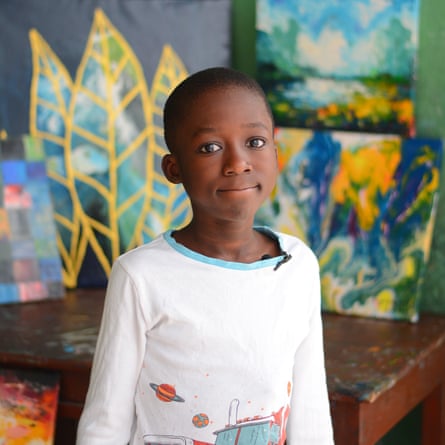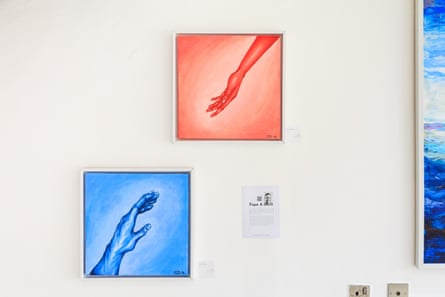On a whitewashed wall at the back of the gallery, seven landscape paintings are on display. The artist, Fiyinfoluwa Adeniji, hopes his collection will sell well. Last year, he made 1m naira ($650) from the sale of two paintings – an impressive achievement for an 11-year-old who first picked up a paintbrush when he was seven.
“I look forward to selling more of my artworks to get a better future, and build a museum when I’m older,” says Adeniji, from Gbagada in Lagos state.
His work is being exhibited at the Children’s Art Gallery (TCAG) in Lagos, Nigeria’s commercial capital. Founded in 2022, the gallery is a social enterprise that encourages young people in the arts, especially those from low-income families.
“We provide a platform for children to connect with a growing network of art collectors around the world,” says the gallery’s co-founder Segun Oni. “We develop young talent, support and nurture the community and work with the artists’ parents to ensure proceeds from the artwork go towards the child’s healthcare, education and creative development.”
About 40% of Nigerians live on less than $2.15 (£1.70) a day – the global measure of extreme poverty – and at least 78% of Lagos households are classified as poor or extremely poor.

“Now is the time when children need this kind of positivity,” says Betty Abah, the founder of the nonprofit Centre for Children’s Health Education, Orientation and Protection in Nigeria, who knows about the gallery through her work with informal communities. “There are a lot of ugly happenings in our world today – conflict, economic depression, family disintegration – which impact children’s mental health. An opportunity to calm and boost their creative acumen is timely.”
Based across two floors on Victoria Island, with sweeping views of the Atlantic Ocean, the gallery’s walls are covered in paintings and drawings by children aged between four and 17.
Any child can submit their work with permission from a parent or guardian, but the gallery also does outreach work in the city and scouts for aspiring artists. Last month, TCAG launched an arts programme for children in the city’s hospitals. So far, 1,400 children have submitted artwork or attended its classes.
Last year TCAG, named art gallery of the year at the 2023 African Fashion and Arts awards, generated $40,000 from the sale of the children’s art to buyers from around the world. At least 80% of the proceeds go to the artist.
Phoebe Giffey-Brohaugh, the co-founder of TCAG, says: “In Nigeria, and many other places, even middle-class families are faced with struggles of living paycheck to paycheck. Low-income families face even more dire circumstances. The gallery and its collector base has helped provide a practical solution to these difficult situations.”
The gallery, which is supported by private donations, opened branches in Accra in Ghana and Harare in Zimbabwe last year.
Adeniji’s talent was spotted by one of the gallery’s tutors, who lives nearby. His mother, Oluwakemi, says his art sales have helped fund his education, “which has been a struggle”, and buy food for the family. “Things are really getting expensive every day in Nigeria,” she says.
Another success story is 12-year-old Faruq Sulaimon, who has one of his works hanging in the reception area of the Art Hotel in Lagos. He sold the charcoal drawing, Who Knows Tomorrow, last year for $1,000, after being encouraged to submit his work by teachers at the Ayowole Academy of Art, a free school that encourages art among underprivileged children.




“I felt happy about selling my artwork. I used the money to get some materials, and I also gave it to my mum because she really tried for us,” says Sulaimon, who is being cared for outside the city after his mother’s recent death.
Zizah Okuego, from Abia state, held his first solo show at the gallery during Lagos Art Week in November. Unknown Countenance featured 28 portraits by the 15-year-old, who is autistic.
His mother, Esther Sule, is proud of his achievements. “Being semi-verbal, art is a way of expression for him and I was happy to see him celebrated, not just because he has autism or because he’s a child artist, but because he’s good at what he does.”
This post was originally published on this site be sure to check out more of their content





